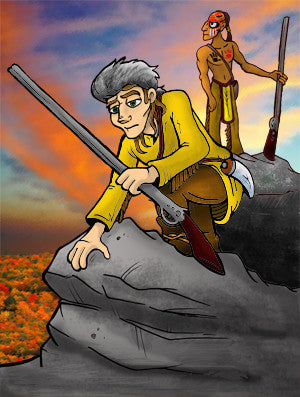
Although I hate to admit it, some novels are almost unreadable. It's not that you can't read them; it's just that as you do read them, you lose the will to read further. The Last of the Mohicans was always one of these books for me. The description is so overbearing and the plot so seemingly thin that I never could muster enough resolve to finish it. Yet when I pushed through, I found one of America's first great adventure stories and the birth of an American archetype: the rugged woodsman.
Don't get me wrong. This novel is kind of a mess. Parts of it are so ridiculous (Hawkeye disguising himself as a bear) that it almost can't be taken seriously. But to balance it out, other parts of the plot are so intriguing and ahead-of-their-time that these flaws can be forgiven.
The novel's mightiest contribution to American Literature though is the character of Hawkeye (or Leatherstocking, Pathfinder, Long Rifle, Natty Bumppo, or whatever name you choose to call him). He is the first American frontiersman character--the tough and savvy loner that influenced everyone from Josey Wales to Han Solo. Since his personality is so individualistic and thoroughly American, he is one of the great characters in fiction, and The Last of the Mohicans is his most famous adventure.
To teach the novel in my own class, I adapted it into four Reader's Theater script-stories. I have found that the adventure of the story really appeals to students who enjoy the outdoors and a little action in their literature!
Keeping all this in mind, here are five reasons to revisit this classic novel:
- Although some have labeled the story as racist, The Last of the Mohicans presents racism in a very real and powerful way. The lead female character, Cora Munro comes from a multi-ethnic background. Her father is a British colonel, and her mother was a descendant of slaves from Barbados. Her ethnicity makes her an outcast in society. Also Alice Munro, Cora's all-white sister, is at first terrified of the idea of being led by an Indian guide, but after being saved by the Mohicans comes to appreciate them as fellow human beings.
- The theme of blended cultures runs throughout the story. Hawkeye, the frontiersman, is effective because he is able to blend his white origins with the Native American knowledge of the woodlands. Even though this blending makes him an outcast from white society, it allows him to survive in the dangerous frontier. America has been called a melting pot because it blends various cultures together, and Hawkeye is the essence of that idea.
- James Fenimore Cooper presents the Native Americans in a sympathetic light. The novel's detractors criticize the presentation of the Native Americans in the story, but Cooper was ahead of his time for presenting them in a sympathetic light, rather than bloodthirsty savages as they were portrayed elsewhere. Although Chingachgook, Hawkeye's Mohican blood-brother, seems to be the typical "noble savage," he is also shown as a father who mourns the loss of his son with real human emotion. Even Magua, the Huron villain of the story, is not presented as completely evil and has real human motivation for seeking revenge on Colonel Munro.
- It is a great adventure story. What other place could provide a better setting for adventure than the American wilderness? This alone made The Last of the Mohicans America's first bestseller in a time when most American stories were set in Europe. Cooper was the first author to find success at writing American characters in an American setting. He also generated a true interest among the Europeans in the culture of the Native Americans.
- It is a dirge for the Native American way of life and the loss of the frontier. The Mohicans are not the only ones who are facing extinction. Hawkeye, too, knows that the wilderness in which he thrives will one day fade away as well. It is the sadness of America that one day all the wild places will be made tame. Cultures will blend, some will dominate, and some will fade away. Hawkeye faces all this stoically--claiming that this is the way of things--but this process is presented with a sadness and a reality that should affect us all.
- Here's a sixth one (just for fun): The character Hawkeye's name inspired the lead character from M*A*S*H and the University of Iowa Hawkeyes.

Thanks for creating resources like this! I have been using the majority of your mythology scripts for 3 years. I hope you continue to make U.S History related scripts in the future. I think your style and humor would help when teaching the Revolutionary War, Westward Expansion, Civil War, and Reconstruction!
Thanks again!